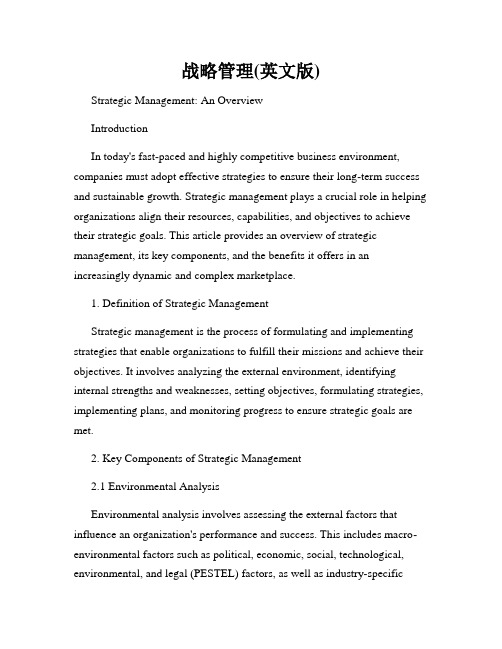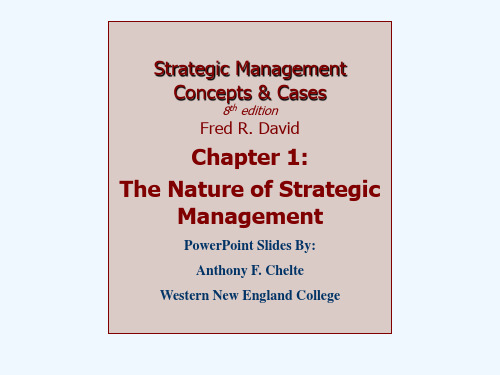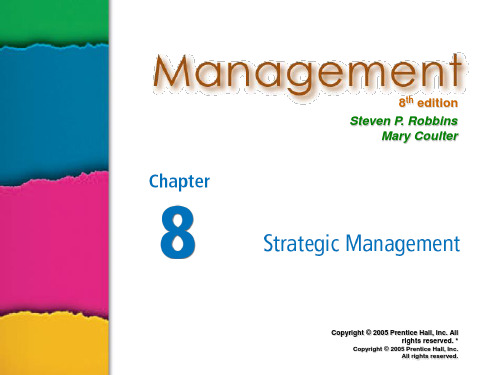战略管理流程讲义英文版10
战略管理英文版最新版教学课件第10章

❖ Geert Hofstede’s Cultural Dimensions 1. Power distance 2. Individualism 3. Masculinity/femininity 4. Uncertainty-avoidance 5. Long-term orientation
• Made possible by: ➢ Falling trade and investment barriers ➢ Advanced telecommunications ➢ Reduced transportation costs ➢ Importance of MNEs and FDIs
Global Strategy: Competing Around the World
Part 2 Strategy Formulation
2–2 2–2
10-2
LO 10-1 Define globalization, multinational enterprise (MNE), foreign direct investment (FDI), and global strategy.
• What defines a U.S. company?
❖ Where it is incorporated? ❖ Where the top management team lives and works is "home"
• Is there a fiduciary responsibility to move the firm to maximize shareholder wealth?
战略管理(英文版)

战略管理(英文版)Strategic Management: An OverviewIntroductionIn today's fast-paced and highly competitive business environment, companies must adopt effective strategies to ensure their long-term success and sustainable growth. Strategic management plays a crucial role in helping organizations align their resources, capabilities, and objectives to achieve their strategic goals. This article provides an overview of strategic management, its key components, and the benefits it offers in an increasingly dynamic and complex marketplace.1. Definition of Strategic ManagementStrategic management is the process of formulating and implementing strategies that enable organizations to fulfill their missions and achieve their objectives. It involves analyzing the external environment, identifying internal strengths and weaknesses, setting objectives, formulating strategies, implementing plans, and monitoring progress to ensure strategic goals are met.2. Key Components of Strategic Management2.1 Environmental AnalysisEnvironmental analysis involves assessing the external factors that influence an organization's performance and success. This includes macro-environmental factors such as political, economic, social, technological, environmental, and legal (PESTEL) factors, as well as industry-specificfactors. Understanding the external environment helps organizations identify opportunities and threats and make informed strategic decisions.2.2 Internal AnalysisInternal analysis focuses on assessing an organization's internal strengths and weaknesses. This includes evaluating its resources, capabilities, and core competencies. By understanding its internal strengths, an organization can leverage them to gain a competitive advantage. Similarly, identifying weaknesses helps organizations address potential areas of improvement and overcome challenges.2.3 Strategy FormulationStrategy formulation involves developing a comprehensive plan to achieve an organization's objectives and competitive advantage. This includes defining the mission and vision, setting strategic objectives, and selecting appropriate strategies. Strategies can be categorized into corporate, business, and functional levels, depending on the scope and focus of the organization's activities.2.4 Strategy ImplementationStrategy implementation is the process of translating strategic plans into actions and ensuring their effective execution. It involves allocating resources, coordinating activities, and monitoring progress. Effective implementation requires strong leadership, effective communication, and a supportive organizational culture.2.5 Evaluation and ControlEvaluation and control involve monitoring and reviewing the progress of strategic initiatives and making necessary adjustments. This includes establishing key performance indicators, conducting regular performance assessments, and taking corrective actions to ensure strategic goals are being achieved. Evaluation and control help organizations stay on track and make informed decisions throughout the strategic management process.3. Benefits of Strategic ManagementStrategic management offers several benefits to organizations:3.1 Clear DirectionBy formulating a clear strategy, organizations establish a sense of direction and purpose. This enables employees to align their efforts and work towards common goals, enhancing overall organizational performance.3.2 Competitive AdvantageStrategic management helps organizations identify unique value propositions and differentiate themselves from competitors. By leveraging their strengths and focusing on key opportunities, organizations can gain a competitive advantage in the marketplace.3.3 Adaptability to ChangeIn today's rapidly evolving business landscape, agility and adaptability are essential for success. Strategic management enables organizations to anticipate and respond to changes in the external environment, ensuring their long-term viability in a dynamic marketplace.3.4 Resource AllocationStrategic management facilitates effective resource allocation by aligning financial, human, and technological resources with strategic objectives. This ensures optimal utilization of resources and maximizes the organization's ability to achieve its goals.3.5 Performance MeasurementBy implementing strategic objectives and monitoring progress, organizations can measure their performance and identify areas for improvement. This allows for continuous learning and ongoing improvement, enhancing overall organizational effectiveness.ConclusionStrategic management is a fundamental process that enables organizations to navigate the complexities of the modern business landscape. By analyzing the external environment, assessing internal capabilities, formulating effective strategies, implementing plans, and evaluating performance, organizations can achieve their objectives and thrive in a highly competitive marketplace. Embracing strategic management is essential for long-term success and sustainability.。
战略管理流程讲义(英文版!11资料

Ch11-3
Strategy & Structure Growth Patterns
Multidivisional Structure
Chapter 11 Structure & Control
Chapter 13
Entrepreneurship
& Innovation
Strategic Actions
Strategic Outcomes
Feedback
Strategic Competitiveness Above Average
Corporate Human
Resources
Finance
Production
Engineering
Accounting
Байду номын сангаас
Sales & Marketing
Human Resources
Ch11-7
Functional Structure for Cost Leadership Strategy
Sales Growth Coordination and Control Problems
Efficient implementation of formulated strategy
Functional Structure
Sales Growth Coordination and Control Problems
Chapter 11
战略管理流程讲义 全套课件

1998 Country
1 Singapore 3 United States 2 Hong Kong 6 Taiwan 5 Canada 8 Switzerland 10 Luxembourg 4 United Kingdom 7 Netherlands 11 Ireland 15 Finland 14 Australia 13 New Zealand 12 Japan 9 Norway 17 Malaysia 16 Denmark 30 Iceland 23 Sweden 20 Austria 18 Chile 19 Korea 22 France 27 Belgium 24 Germany 2第5八页,共S3p41a页in。
Competitiveness Index 1999 2.12 1.58 1.41 1.38 1.33 1.27 1.25 1.17 1.13 1.11 1.11 1.04 10.1 1.00 0.92 0.86 0.85 0.59 0.58 0.37 0.57 0.46 0.44 0.39 0.37 0.16
The global economy is changing
• People, goods, services and ideas move freely across geographic boundaries
• New opportunities emerge in multiple global markets
Acquisitions & Restructuring
Chapter 8
International Strategy
Chapter 9
Cooperative Strategies
Strategy Implementation
战略管理流程讲义(英文版13)剖析

Requires a decision on which corporate resources to deploy for new technology development and which innovative ideas to bring to market
Acquisitions & Restructuring
Chapter 8
International Strategy
Chapter 9
Cooperative Strategies
Strategy Implementation
Chapter 10 Corporate Governance
Chapter 12 Strategic Leadership
Create it! Co-opt it! Buy it!
Ch13-6
Internal Corporate Venturing
Corporate Intrapreneurship can occur as either a bottom-up process or as a top-down process
Chapter 11 Structure & Control
Chapter 13
Entrepreneurship
& Innovation
Strategic Actions
Strategic Outcomes
Feedback
Strategic Competitiveness Above Average
战略管理课件英文版

Organizing Themes
• Global considerations impact virtually all strategic decisions.
• E-commerce has become a vital strategic management tool.
• The natural environment has become an important strategic issue.
▪ Widely viewed as panacea for problems
Brief History
• 1980s
➢ Strategic planning cast aside
▪ Planning models did not yield higher returns
• 1990s–2000
➢ Revival of strategic planning
• Strategic planning
➢Refers to:
▪ Strategy formulation
Brief History
• 1950s
➢ Term strategic planning originates
1960s – 1970s ➢ Strategic planning very popular
1. Strategists 2. Vision statements 3. Mission statements 4. External opportunities and threats 5. Internal strengths and weaknesses
Key Strategic Management Terms (Cont’d)
战略管理流程讲义(英文版!08资料

Identify International Opportunities
Increased Market Size Return on Investment Economies of Scale and Learning Location Advantage
Explore Resources and
- Can spread costs over a larger sales base - Increase profit per unit
Location Advantages
Low cost markets may aid in developing competitive advantage
May achieve better access to: - Raw materials - Lower cost labor
Chapter 8
International Strperative Strategies
Strategy Implementation
Chapter 10 Corporate Governance
Chapter 12 Strategic Leadership
Chapter 11 Structure & Control
- Key customers - Energy
- Key suppliers
- Natural resources Ch8-6
Porter’s Determinants of National Advantage
Modes of Entry
Exporting
Exporting
Strategic Alliances
Management Problems and Risk
战略管理流程讲义(英文版!03资料

And... Will environmental changes make our core competencies obsolete?
Are substitutes available for our core competencies?
Are our core competencies easily imitated?
such as capital equipment, skills of employees, brand names, finances and talented managers
Ch3-8
Resources
What a firm Has...
What a firm has to work with: its assets, including its people and the value of its brand name
Ch3-5
Discovering Core Competencies
Resources
* Tangible * Intangible
Ch3-6
ResouБайду номын сангаасces
What a firm Has...
What a firm has to work with:
its assets, including its people and the value of its brand name
* Financial * Physical * Technological * Organizational
Intangible Resources
* Valuable * Rare * Costly to Imitate * Nonsubstitutable
战略管理流程讲义(英文版!06资料

Tangible Resources Intangible Resources
Ch6-7
Motives, Incentives, and Resources for Diversification
Resources
Incentives
Managerial Motives
Chapter 6
Corporate-Level Strategy
Ch6-1
Strategic Inputs
Chapter 2 External Environment
Chapter 3 Internal Environment
Strategic Intent Strategic Mission
The Strategic Management
Corporate Strategy is what makes the corporate whole add up to more than the sum of its business unit parts
Ch6-4
Levels and Types of Diversification
Low Levels of Diversification
Motives to Enhance Strategic Competitiveness
Resources Incentives
Economies of Scope Market Power
Financial Economies
Managerial Motives
Ch6-6
Motives, Incentives, and Resources for Diversification
战略管理流程讲义(英文版13)

Competitive Advantage
Timely
Ch13-5
Fostering Entrepreneurial Innovation
Three approaches:
Internal Corporate Venturing Cooperating to Produce Innovation Acquiring Innovative Capability
Returns
Ch13-2
Defining Entrepreneurship
Corporate Entrepreneurship
Firm’s capabilities to develop new goods or services and manage the innovation process
The Strategic Management
Process
Strategy Formulation
Chapter 4
Business-Level Strategy
Chapter 5
Competitive Dynamics
Chapter 6
Corporate-Level Strategy
Chapter 7
Ch13-4
Innovation and Competitive Advantage
Difficult for competitors to imitate
Commercially exploitable with present capabilities
Provides significant value to customers
Autonomous strategic behavior is a bottom-up process through which Product Champions pursue new product ideas to commercialization
战略流程报告英文

“Can America Lose These Jobs and Still Prosper?”
– July 2003
“American legislators are accusing India of stealing jobs”
2 Average 1996-99
3 Average 1989-2000
4 Average 2003-13
Source: NBER; BLS; Kletzer; McKinsey Global Institute
8
20030520DL-ZXE332(ITES, Board Pres.)(JS)-7
5
INDIA CAPTURES 33 CENTS FROM EACH DOLLAR OF SPEND OFFSHORED BY THE U.S.
Value accrued from $1 of U.S. spend offshored1
Dollars; 2002
0.33
0.03
0.01
0.09
0.10
• Off-shored jobs small fraction of
expected retirements/lay-offs
Negative emotional impact at the customer equally real
• Real people and communities are
• Will the BPO
phenomenon plateau out in the next few years?
• Even if it survives,
战略管理(罗宾斯管理学第版讲义全集-英文版)资料

• Discuss the implications of dynamic and uncertain environments on organizational strategy.
• Explain the rule of three and its significance to strategic management.
strategy. • Describe two renewal strategies.
Copyright © 2005 Prentice Hall, Inc. All rights reserved. *
8–3
L E A R N I N G O U T L I N E (cont’d)
Follow this Learning Outline as you read and study this chapter.
• Discuss what studies of the effectiveness of strategic management have shown.
The Strategic Management Process
• List six steps in the strategic management process.
Copyright © 2005 Prentice Hall, Inc. All rights reserved. *
8–4
L E A R N I N G O U T L I N E (cont’d)
Follow this Learning Outline as you read and study this chapter.
Strategic Management Process战略管理课件

2,差异化(differentiation)战略;
3,集中化或者说聚焦(focusing)战略。
此外,在显著不同的产业发展阶段上, 可供选择的战略方案亦不同。例如:
处于萌芽期、 胎期的产业,建立先占优 势(first mover advantage)的必要性和 可能性;在成熟期产业里,市场警讯 (market signaling)、价格领导、维持 竞争优势的产品差异化等战略。
内部环境分,探 索竞争优势的来源,特别是能够产生竞 争优势的资源(resources)和潜能 (capabilities),以及特异能力(distinctive
competencies)
SWOT分析的目的在于寻找能够使公司 的资源与潜能可以和所处市场环境相吻 合(fit,match or align)的战略。易言之, 经由SWOT分析所产生的战略方案,应 该是建立在公司的优势之上,充分利用 机会,避免劣势,对抗威胁。
structure
战略 执行 组织结构与战略控制
设计: Control system
战略管理程序由两大部分组成, 即:
1,战略的形成 2,战略的执行
Strategy formulation 战略形成
使命:说明组织存在的理由,界定组织 营运的范围,即组织应从事何种事业。
主要目标:明确指出组织所希望达成的 长期目标。营利组织多以层级目标的方 式来运作。如General Electric公司在Jack Welch执政时期,将“股东财富极大化” 摆在最高层,在目标层级的第二层上是
1,多国本土化(multidomestic)战略; 2, 国际化(international)战略;
- 1、下载文档前请自行甄别文档内容的完整性,平台不提供额外的编辑、内容补充、找答案等附加服务。
- 2、"仅部分预览"的文档,不可在线预览部分如存在完整性等问题,可反馈申请退款(可完整预览的文档不适用该条件!)。
- 3、如文档侵犯您的权益,请联系客服反馈,我们会尽快为您处理(人工客服工作时间:9:00-18:30)。
Entrepreneurship
& Innovation
Strategic Actions
Strategic Outcomes
Feedback
Strategic Competitiveness Above Average
Returns
Ch10-2
Corporate Governance
Process
Strategy Formulation
Chapter 4
Business-Level Strategy
Chapter 5
Competitive Dynamics
Chapter 6
Corporate-Level Strategy
Chapter 7
Acquisitions & Restructuring
Example: Overdiversification because increased product diversification leads to lower employment risk for managers and greater compensation
Solution: Principals engage in incentive-based performance contracts, monitoring mechanisms such as the board of directors and enforcement mechanisms such as the managerial labor market to mitigate the agency problem
Chapter 8
International Strategy
Chapter 9
Cooperative Strategies
Chapter 10 Corporate Governance
Chapter 12 Strategic Leadership
Chapter 11 Structure & Control
Ch10-6
Manager and Shareholder Risk and Diversification
Shareholder
(Business)
Managerial
Risk Profile
(Employment)
S
Risk Profile
M
Risk
Dominant Business
A Related Related B Constrained Linked
managers Ch10-4
Agency Theory
An agency relationship exists when:
Shareholders (Principals)
Firm Owners
Hire
Agency Relationship
Risk Bearing Specialist (Principal)
Ch10-3
Separation of Ownership and Managerial Control
Basis of the modern corporation
Shareholders purchase stock, becoming Residual Claimants
- Shareholders reduce risk efficiently by holding diversified portfolios
Professional managers contract to provide decisionmaking
Modern public corporation form leads to efficient specialization of tasks
- Risk bearing by shareholders - Strategy development and decision-making by
Chapter 10
Corporate Governance
Ch10-1
Strategic Inputs
Chapter 2 External Environment
Chapter 3 Internal Environment
Strategic Intent Strategic Mission
The Strategic Management
Managerial DecisionMaking Specialist (Agent)
Managers (Agents)
Decision Makers
which creates
Ch10-5
Agency Theory
The Agency problem occurs when:
- The desires or goals of the principal and agent conflict and it is difficult or expensive for the principal to verify that the agent has behaved appropriately
Concerned with identifying ways to ensure that strategic decisions are made effectively
Used in corporations to establish order between the firm’s owners and its top-level managers
Corporate Governance is a relationship among stakeholders that is used to determine and control the strategic direction and performance of organizations
Level of Diversification
Unrelated Businesses
Ch10-7
Agency Theory
Principals may engage in monitoring behavior to assess the activities and decisions of managers
